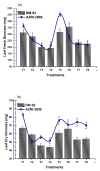Seed Priming with Glutamic-Acid-Functionalized Iron Nanoparticles Modulating Response of Vigna radiata (L.) R. Wilczek (Mung Bean) to Induce Osmotic Stress
- PMID: 37420969
- PMCID: PMC10141484
- DOI: 10.3390/mi14040736
Seed Priming with Glutamic-Acid-Functionalized Iron Nanoparticles Modulating Response of Vigna radiata (L.) R. Wilczek (Mung Bean) to Induce Osmotic Stress
Abstract
Rising soil salinity is a major concern for agricultural production worldwide, particularly in arid and semi-arid regions. To improve salt tolerance and the productivity of economic crop plants in the face of future climatic changes, plant-based solutions are required to feed the continuously increasing world population. In the present study, we aimed to ascertain the impact of Glutamic-acid-functionalized iron nanoparticles (Glu-FeNPs) on two varieties (NM-92 and AZRI-2006) of mung beans with different concentrations (0, 40 mM, 60 mM, and 80 mM) of osmotic stress. The result of the study showed that vegetative growth parameters such as root and shoot length, fresh and dry biomass, moisture contents, leaf area, and the number of pods per plant were significantly decreased with osmotic stress. Similarly, biochemicals such as protein, chlorophylls, and carotenes contents also significantly declined under induced osmotic stress. The application of Glu-FeNPs significantly (p ≤ 0.05) restored both the vegetative growth parameters and biochemical contents of plants under osmotic stress. The pre-sowing treatment of seeds with Glu-FeNPs significantly ameliorated the tolerance level of Vigna radiata to osmotic stress by optimizing the level of antioxidant enzymes and osmolytes such as superoxide dismutase (SOD), peroxidase (POD), and proline contents. Our finding indicates that Glu-FeNPs significantly restore the growth of plants under osmotic stress via enhancing photosynthetic activity and triggering the antioxidation system of both varieties.
Keywords: Glu-FeNPs; inorganic fertilizers; mung bean; osmotic stress; seed priming.
Conflict of interest statement
The authors declare that they have no known competing financial interest or personal relationships that could have appeared to influence the work reported in this paper. The authors declare no conflict of interest.
Figures















References
-
- Wang Y.H., Ying Y., Chen J., Wang Y.C. Transgenic Arabidopsis over expressing Mn-SOD enhanced salt-tolerance. Plant Sci. 2014;167:671–677. doi: 10.1016/j.plantsci.2004.03.032. - DOI
-
- GoP . Economic Survey. Government of Pakistan, Finance Division, Economic Adviser’s Wing; Islamabad, Pakistan: 2005. p. 233.
-
- Adjel F., Kadi Z., Bouzerzour H., Benmahammed A. Salt stress effects on seeds germination and seedling growth of Barley genotypes. J. Agric. Sustain. 2013;3:223–237.
-
- Carillo P., Cirillo C., DeMicco V., Arena C., Depascale S., Rouphael Y. Morpho-anatomical, physiological and biochemical adaptive responses to saline water of Bougainvillea spectabilis Willd. trained to different canopy shapes. Agric. Water Manag. 2019;212:12–22. doi: 10.1016/j.agwat.2018.08.037. - DOI
-
- Zeeshan M., Meiqin L., Shafaque S., Paul H., Feibo W. Drain water management for salinity mitigation in irrigated agriculture. Agronomy. 2020;10:127. doi: 10.3390/agronomy10010127. - DOI
Grants and funding
LinkOut - more resources
Full Text Sources

